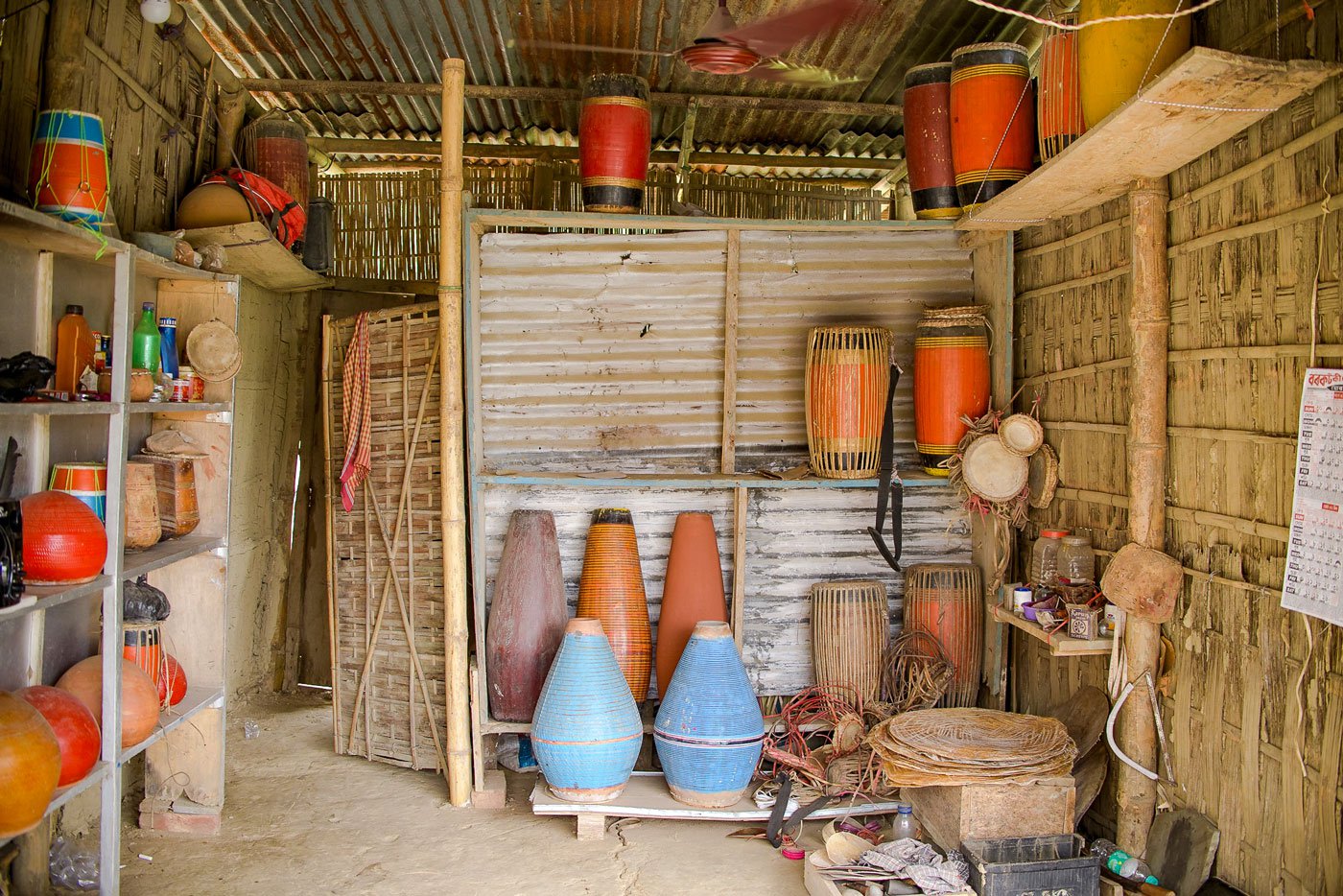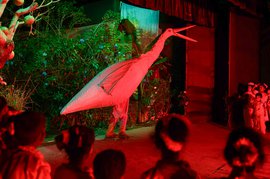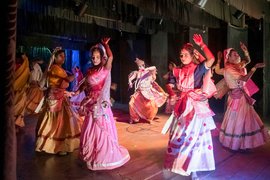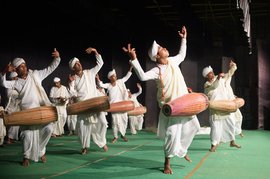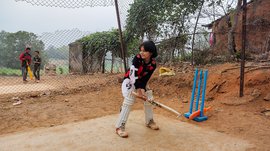Assamese khol drums have a lower (bass) sound profile than the Bengali khol . The dhol has a higher pitch than the negera. Giripod Badyokar knows this well. A maker of percussion instruments, it’s the kind of knowledge that he uses in his everyday work.
“Young boys show me their smartphones and tell me to adjust the tuning to a particular scale,” says the veteran craftsman based in Majuli, Assam. “We don’t need the app.”
Giripod explains that even with a tuner app, the process is one of trial and error. It requires the leather membrane of the percussion instrument to be properly aligned and tightened. “Only then will the tuner app work.”
Giripod and his son Podum come from a long line of Badyokars (or Badyakars). Also known by the name Dhuli or Sabdakar, the community known for making and repairing musical instruments, is recognised as a Scheduled Caste in the state of Tripura.
Podum and Giripod primarily make
dhol, khol
and
tabla.
“Since
the
satras
are here, we get work all year round,”
Podum says. “We can make enough to get by.”

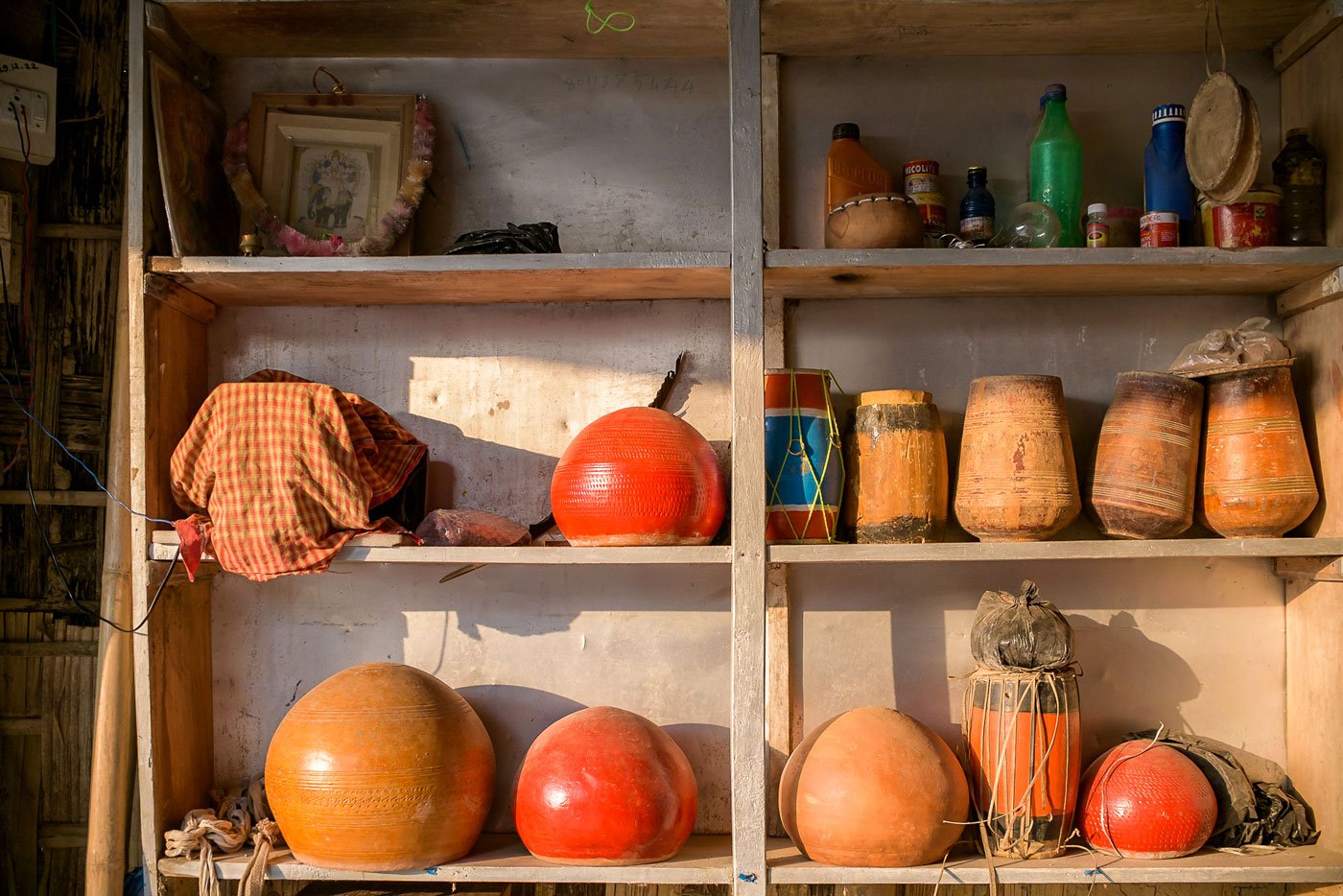
Left: Podum Badyokar sits in his family’s shop in Majuli, Assam. Right: Negeras and small dhols that have come in for repairs line the shelves
Earnings pick up during the festival season beginning with the month of Fagun (February-March) and the Ali Aye Ligang spring festival of the Mising (or Mishing) community. Dhols are an integral component of the Gumrag dance performed during the festival and the demand for new dhols and the repairing of old peaks in the month of Sot (March-April). The celebration of Bohag Bihu – a major festival in the state – during spring also raises the demand for dhols .
Negeras and khols are in high demand during the month of Bhadro. Percussion instruments play an important role in Assamese cultural events – from Raas to Bihu. There are an estimated six kinds of drums especially popular in Assam, many of which are made and used here in Majuli. Read: Raas Mahotsav and the satras of Majuli
Sitting in the hot April sun outside his shop, Podum scrapes the hair off the cattle hide that will eventually become the leather membrane or taali for a tabla, negera, or khol. All of the five music shops on the island of Majuli in the Brahmaputra are run by Badyokar families who belong to the migrant Bengali community.
“My father says, since he learnt by observing, I must do the same,” the 23-year-old says. “ Hatot dhori xikai nidiye [He doesn’t hold hands while teaching]. He doesn’t even correct my mistakes. I have to correct them myself by observing.”
The leather Podum is busy cleaning is the complete
hide of an ox which they have bought for around Rs. 2,000. The first step is
matting the hair on the hide using
footsai
(hearth ash)
or dry sand. It is then scraped off using a
botali
, a flat-edged
chisel.

Podum scrapes off the matted hair from an animal hide using some ash and a flat-edged chisel
Circular sheets are cut from the cleaned hide using a curved dao blade called ektera . These will become the taali [leather membrane]. “The ropes tying the taali to the body of the instrument are also made of leather,” explains Podum. “It comes from a younger animal and is softer and finer.”
The syahi (circular black section in the centre of the taali ) is made of powdered iron or ghun mixed into a paste with boiled rice. “It [ ghun ] is made in a machine,” he says, holding a small heap of it in his palm. “It’s finer than the kind you get from the local ironsmith which is coarse, flaky and bruises your hand.”
The young craftsman transfers some of the dark grey ghun into this reporter’s palm. The powder is surprisingly heavy, despite the small quantity.
Applying the ghun to the taali needs extra attention and care. The craftsmen clean the taali 3-4 times before applying a layer of boiled rice to it and drying it under the sun. The starch in the rice makes the taali sticky. Before the taali dries up completely, a layer of syahi is applied and the surface is polished using a stone. This is done thrice with a 20-30 minute interval between each layer. It is then kept under shade for about an hour.
“Until it is completely dry, we have to keep
rubbing. Traditionally, it is done 11 times. If it is cloudy, the process can
take an entire week.”


Left: The curved dao blade, two different botalis (flat-edged chisels) and a screwdriver used like an awl are some of the tools used by the craftsmen. Right: The powdered iron or ghun used to paint the circular section of the taali is heavier than it looks


Giripod and Podum cut small sheets from the hide to fit the instruments being worked on. A toolbox holds the many items necessary for preparing the leather: different types of chisels, blades, a hammer, mallet, stones and sandpaper
*****
Giripod is the youngest of four brothers and started helping out in the family business around age 12. He lived in Kolkata then. When his parents passed away in quick succession, he found himself all alone.
“I didn’t have the heart to learn this craft anymore,” he recalls. When he found love a few years later, he decided to move to Assam. Initially, he worked in a shop making dhols . Later he worked in a saw mill for a few years and then in the logging business. In dangerous journeys of log-filled trucks making their way downhill through muddy roads in monsoon, “I saw many deaths in front of my eyes,” he recalls.
He returned to the craft and worked in Jorhat for 10-12 years. All his children – three girls and a boy – were born there. Trouble with some Assamese boys over the return of a dhol that the group had borrowed prompted the local police to advise him to set up shop elsewhere since the boys, known goons, could cause more trouble.
“I also thought since we are Bengalis, if they gang up and things become communal, there will be a risk to my life and my family,” he says. “So I decided to leave Jorhat [for Majuli].” With several satras (Vaishnavite monasteries) established in Majuli, he would get steady work making and repairing khol drums extensively used in sattriya rituals.
“These places used to be a jungle and there
weren’t many shops around.” He opened his first shop in Balichapori (or Bali Chapori) village and
four years later, moved it to Garamur. In 2021 the family opened a slightly
bigger second shop in Naya Bazar, around 30 kilometres away from the first.


Left: Surrounded by other musical instruments, a doba (tied with green thread) sits on the floor awaiting repairs. Right: Bengali khols (in blue) are made from clay and have a higher pitch than the wooden Assamese khols (taller, in the back)
A line of khols adorns the walls of the shop. Bengali khols, made from clay, are made in West Bengal and priced Rs. 4,000 or more based on their size. Assamese khols , by contrast, are made from wood. Dhols range from Rs. 5,000 and upwards depending on the wood used. Changing the leather and rebinding it will cost a customer around Rs. 2,500.
A doba belonging to one of the namghars (prayer houses) in Majuli sits on the floor of the shop. It is made from a used drum of kerosene. Some dobas are made of brass or aluminium. “If they ask us to source the drum and then make the doba , we do that. Otherwise, the customer can also bring the drum and we will fix the leather,” Podum says. This one has come in for repairs.
“Sometimes we have to go to the satra and namghar to repair the doba ,” he explains further. “On the first day we go and do the measurements. The next day we go with the leather and repair it in the satra itself. It takes us about an hour.”
Leatherworkers have a long history of being discriminated against. “The people who play the dhol put saliva on their fingers to play the dhol . The washer of the tubewell is also made from leather,” says Giripod. “So discriminating in terms of jaat-paat is without logic. Objecting to the skin is useless.”
Five years ago the family bought a piece of land
and built a home for themselves in Naya Bazar. They live in a mixed community
of Mising, Assamese, Deori and Bengali people. Have they ever faced
discrimination? “We are Manidas.
People from the Rabidas
community who skin the dead cattle are discriminated against a bit. The
caste-based discrimination is more in Bengal. Here it is not like that,”
Giripod answers.
*****
The Badyokars buy the
whole hide of an ox for around Rs. 2,000, usually from Muslim traders in Kakojan, Jorhat. The
hides here are more expensive but of better quality than the ones in the nearby
Lakhimpur district. “They treat the skins with salt which reduces the
durability of leather,” says Podum.


Procuring skins for leather has become difficult these days, craftsmen say. Rolls of leather and a set of khols awaiting repairs are stored in one corner of the shop
Procuring skins has become difficult these days due to changing laws. The Assam Cattle Preservation Act, 2021 prohibits the slaughter of all cows. It allows the slaughter of other cattle but only if a registered veterinary officer certifies the animal to be over 14 years of age or permanently incapacitated. This has driven up the cost of skins, increasing the price set for new instruments and repair work. “People complain about the increased price but nothing can be done about it,” says Podum.
Giripod was once returning home from a job with his leather work equipment and dao blades when the police stopped him at a checkpost and started asking questions. “My father even told them I work with so and so and came here to deliver an instrument” but the police refused to let him go.
“As you know, the police won’t trust us. They thought he was going to slaughter some cows,” Podum recalls. In the end, Giripod had to give the police Rs. 5,000 to let him return home.
Transporting ghun is risky too as it is also used in making bombs. Giripod buys a kilogram or two at a time from a big shop in Golaghat district which has the license. A round trip to the shop by the shortest route takes around 10 hours and involves crossing the Brahmaputra on a ferry.
“If the police see it or catch us carrying it, there is a risk of facing jail time,” Giripod says. “If we can convince them by demonstrating how we use it on the tabla , then good. Otherwise, we will go to jail.”
This story is supported by a fellowship from Mrinalini Mukherjee Foundation (MMF).